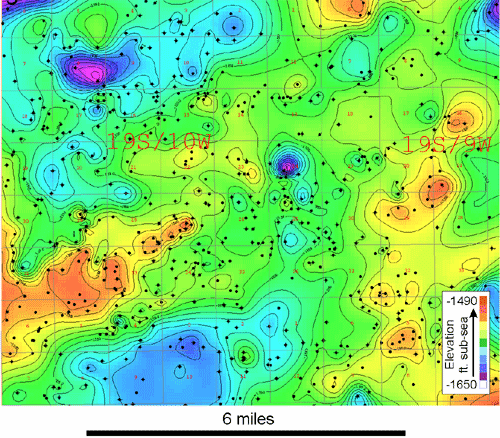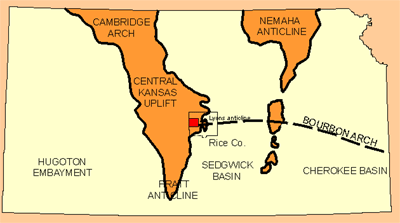
Integrating Plug to Well-Scale Petrophysics with Detailed Sedimentology to Quantify Fracture, Vug, and Matrix Properties in Carbonate Reservoirs
Kansas Geological Survey
Open-file Report 99-47
 |
Integrating Plug to Well-Scale Petrophysics with Detailed Sedimentology to Quantify Fracture, Vug, and Matrix Properties in Carbonate Reservoirs |
Kansas Geological Survey Open-file Report 99-47 |
Arbuckle and equivalent Midcontinent reservoirs are generally considered to have favorable reservoir qualities directly related to structural highs that resulted from regional uplifts and prolonged subaerial exposure and development of karstic features in the upper 30 to 50 feet of the Arbuckle. Examination of core indicates that karstic processes variously destroyed or enhanced porosity. In some areas karstification significantly enhanced porosity and permeability in a pattern similar to modern karst systems (Figure 6) where dissolution follows fracture systems. Whereas much attention has been previously directed at karst features, matrix properties also play an important and even dominant role in some reservoirs. The Arbuckle strata have experienced pervasive but mostly non-fabric destructive dolomitization(s), allowing inference of depositional facies and paragenetic sequence of events that affected these strata. The striking feature in the cores is the abundance of matrix porosity (>50%; intercrystalline, moldic, fenestral, vuggy) throughout the entire lengths of the cores related to depositional facies, early diagenesis, and dolomitization, and unrelated to the post-Arbuckle subaerial exposure surface. Oil stains indicate that these frequently thin intervals may represent significant storage for vuggy and fractured systems and may also represent dominant flow intervals in both vuggy/fractured and unfractured systems.

Figure 6
Pattern of numerous irregular closed contours is suggestive of karst terrain

|
|
e-mail : webadmin@kgs.ku.edu
Last updated November 2002
http://www.kgs.ku.edu/PRS/Poster/1999/99-47/P1-06.html